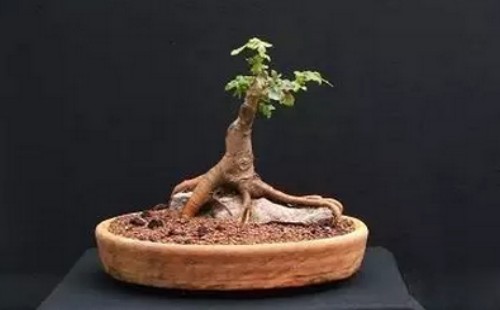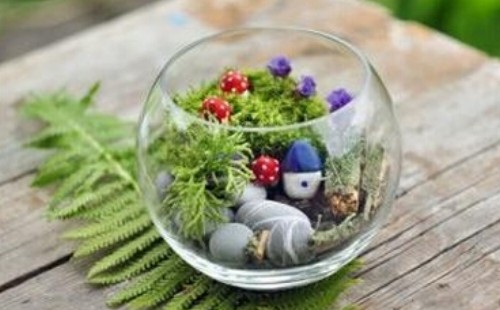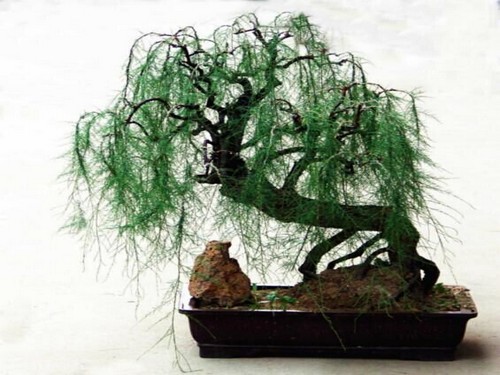Do it yourself with a stone bonsai (process diagram)
Stone-attached bonsai is a kind of bonsai work that combines trees and rocks by certain means or techniques to make it an organic whole, so as to improve the ornamental progress and artistry. Making a perfect stone bonsai not only reflects the process that the bonsai creation comes from nature and is better than nature, but also comes from life but is higher than the artistic value of life.
To put it simply, stone-attached bonsai is a bonsai work based on rocks, which allows trees to grow on the rocks and keep them growing normally. So, have you ever thought of making stone bonsai yourself? Today, the editor teaches you the process of making stone bonsai by hand (illustration).

This is a pot of stone bonsai made of maple trees. Strictly speaking, it is not a bonsai work, because the production has not yet been completed, and the top of the maple tree needs to be cultivated for some time. But it is obvious that the root design and layout of the maple have been done, and it took six years before and after making such a pot, so let's take a look at the production process.
1. This is a wind tree seedling bred by cutting, which has been raised on the ground for 2 years. Later, we plan to use it to make a maple bonsai with stone.
2. After another 2 years of stocking and cultivation, we can dig it out and put it on a common-looking stone to make maple stone bonsai.
3. Comb the root system of the maple so that it can only stretch on the stones. After placing the root system, use a rope to monitor and tie it up so that the root is fixed to the stone. The material of the rope should be perishable so that it will rot and fall off naturally without having to untie the rope at a later stage, which will not affect the root growth of the plant.
4. Next, a transparent plastic film is used to wrap the roots of the plant together with the stones, which ensures that the roots of the maple can fit more closely with the stones and let them grow attached to the stones. All you need to do is to expose the upper part of the tree. At the same time, the red arrow part is "sacrificial branch", which needs to be retained at this time, in order to thicken the root of the plant, and then wait for the opportunity to cut it off later.
5. Then it will be planted on the ground again. It can be seen that this is the maple tree that grew to the fifth year, not only survived smoothly, but also grew better. This has laid a solid foundation for us to proceed to the next step.
6. By the 6th year, that is, after 2 years of replanting, after pruning, pruning and cultivation, we have a good plant shape. And then ready to dig it out, pot and transplant.
7. after 6 years of cultivation, the maple seedlings were excavated from the ground planting state. after removing the soil and washing the roots, we can see that the roots of the maple seedlings have been very developed.
8. If you remove the plastic film that covered the root of the maple tree, you can find that the root is much thicker, and then put it on the pot in time after trimming the root.
9. The next step is to remove the "sacrificial branches" of the plant. Before that, we let the "sacrificial branches" grow freely and original for several years, mainly in order to make the lower branches grow thick. At present, the lower branches have grown thick, and the "sacrificial branches" have become superfluous branches, so we should cut them off in time.
10, this is a good maple stone bonsai, is a stone bonsai work cultivated and created after 6 years, we look at the effect, how do you feel? Next, we only need to cultivate the top branches of the maple.
Time: 2019-05-25 Click:
- Prev

The method of making stone bonsai by yourself
Many potted friends like to create a small and fresh environment in their own small world, and making small fresh bonsai is undoubtedly an ideal choice. From the moment the green miniature bonsai is placed on the table, I believe that the whole person will be in a good mood and feel comfortable. Especially in the hot summer.
- Next

How to make imitation pine-like Tamarix bonsai
People know that Tamarix is a good material for creating weeping willow bonsai, and its soft charm is particularly lovable. Originally wanted to learn from Wang voter master, but also with Tamarix to create a weeping willow-style bonsai, but now the Tamarix material is tall and upright, especially strong, how can it be graceful and graceful! What to do
Related
- Fuxing push coffee new agricultural production and marketing class: lack of small-scale processing plants
- Jujube rice field leisure farm deep ploughing Yilan for five years to create a space for organic food and play
- Nongyu Farm-A trial of organic papaya for brave women with advanced technology
- Four points for attention in the prevention and control of diseases and insect pests of edible fungi
- How to add nutrient solution to Edible Fungi
- Is there any good way to control edible fungus mites?
- Open Inoculation Technology of Edible Fungi
- Is there any clever way to use fertilizer for edible fungus in winter?
- What agents are used to kill the pathogens of edible fungi in the mushroom shed?
- Rapid drying of Edible Fungi

